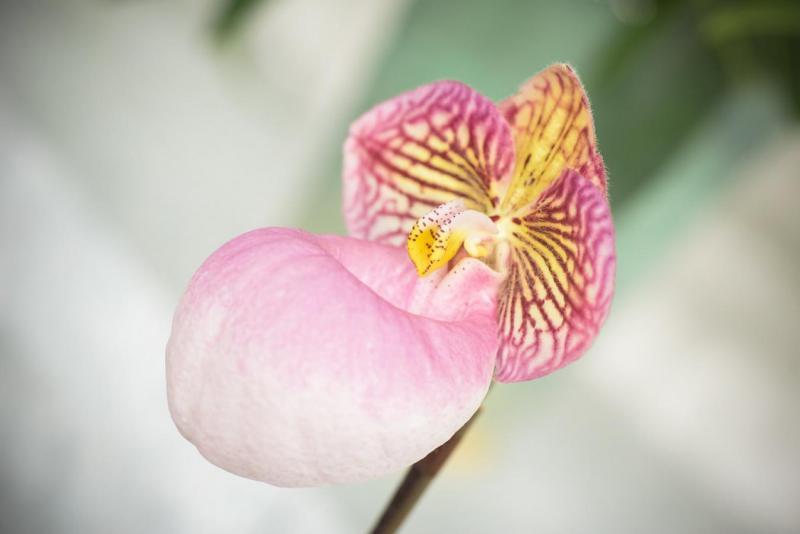Paphiopedilum micranthum
Also known as: The Tiny Flowered Paphiopedilum or Paphiopedilum micranthum var. oblatum Paphiopedilum micranthum f. alboflavum Paphiopedilum micranthum var. alboflavum Paphiopedilum micranthum var. glanzeanum Paphiopedilum micranthum ssp. eburneum Paphiopedilum micranthum h.f. aureum Paphiopedilum micranthum ssp. eburneum h.f. album Paphiopedilum micranthum h.f. marginatum Paphiopedilum micranthum h.f. albo-flavum Paphiopedilum micranthum f. kienii Paphiopedilum micranthum h.f. alboviride Paphiopedilum micranthum h.f. album Paphiopedilum micranthum h.v. extendatum Paphiopedilum micranthum f. glanzeanum Paphiopedilum micranthum var. eburneum Paphiopedilum globulosum Paphiopedilum micranthum h.v. kwong see Paphiopedilum micranthum h.f. alba Paphiopedilum micranthum h.v. micranthum in the subfamily: Cypripedioideae
Native to: China
General Information
The Tiny Flowered Paphiopedilum is a small warm growing epiphytic, lithophytic or terrestrial orchid belonging to the sub family Cypripedioideae native to China.
Plant Description
Each new growth has numerous leathery leaves that grow to 2.5-14cm long
Substrate(s)
- Coarse
- Spaghnum Moss
Care Notes
This orchid goes into a dormancy phase during winter, during this phase it is best not to provide water unless the plant is starting to look thirsty. The lack of water increases the chance of flowering in spring, and also reduces the likelihood of any rot forming. Do not resume watering until new growth has appeared and is growing strongly.
Often a period of intense growth occurs after dormancy. During this time the amount of light, water and fertiliser the plant receives will directly impact the amount of growth that occurs during this time, and in the case of seedlings, will reduce the time required to reach maturity.
It's recommended to heavily reduce the water amount at the middle to end of autumn to trigger dormancy. Leaves on older bulbs will begin to drop during this time while the newer bulbs continue to mature until terminal leaves appear at the tip of the pseudobulbs.
Repotting can be done any time of the year though it's best to do it in early spring when new growth is appearing as this also means new roots will appear to help the plant anchor into the new media and offset any damage to established roots during the repotting process.
Climate
Grows at low to high elevations. Rainfall ranges from 8mm to 328mm per day, heaviest in August and lightest in December. Temperature ranges from 8C to 29C, highest in July (22C to 29C) and lowest in December (8C to 15C).
Watering
These orchids prefer a wet-dry cycle between waterings, they should be watered frequently but only when the moisture is approaching dryness, where the pot feels light and/or the media looks dry. Keep an eye on mounted orchids in warm weather as they may dehydrate quickly.
Fertiliser
These orchids do not need to be regularly fertilised and roots may be sensitive to salt build-up, dying back and therefore impairing the plants growth or even killing it.
If fertilising, use half to quarter of the recommended amount of fertiliser. If they receive fertiliser as part of a collection, be sure to flush out the pots regularly with fresh water and monitor the roots by checking how much resistance is given by the plant when nudged in its pot or mount. If the plant becomes wobbly or loose, repot in fresh mix or rinse the media/mount thoroughly and do not fertilise for at least 3 months.
Be sure to flush out excess fertiliser by running water through the media regularly year round. Use a high Nitrogen fertiliser during Summer. Use a high Phosphorous fertiliser during Summer. Reduce fertiliser when plant is dormant during Spring.Potting
These plants can be sensitive to repotting though should not require repotting regularly. Repotting should be done when the mix has broken down to the point that it doesn't absorb water or holds onto water for far too long, usually the plant shows a decline in growth as well. Repotting is best done after the growing season when the plant has died back.
The mix should be free draining, with a blend of 30% inorganic ingredients such as coarse sand, gravel or perlite, mixed in with about 70% organic ingredients such as peat, leaf litter or decomposed bark. Avoid commercial potting mixes as they can vary wildly and may contain "wetting agents" that can hold onto water for loo long, causing rotting and stunted growth.
This plant does very well in baskets or suspended pots Repotting is best done annually.





















